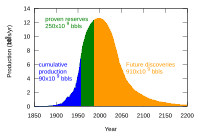
Photo from wikipedia
Understanding and forecasting mobility patterns and travel demand are fundamental and critical to efficient transport infrastructure planning and service operation. However, most existing studies focused on deterministic demand estimation/prediction/analytics. Differently,… Click to show full abstract
Understanding and forecasting mobility patterns and travel demand are fundamental and critical to efficient transport infrastructure planning and service operation. However, most existing studies focused on deterministic demand estimation/prediction/analytics. Differently, this study provides confidence interval based demand forecasting, which can help transport planning and operation authorities to better accommodate demand uncertainty/variability. The proposed Origin-Destination (OD) demand prediction approach well captures and utilizes the correlations among spatial and temporal information. In particular, the proposed Probabilistic Graph Convolution Model (PGCM) consists of two components: (i) a prediction module based on Graph Convolution Network and combined with the gated mechanism to predict OD demand by utilizing spatio-temporal relations; (ii) a Bayesian-based approximation module to measure the confidence interval of demand prediction by evaluating the graph-based model uncertainty. We use a large-scale real-world public transit dataset from the Greater Sydney area to test and evaluate the proposed approach. The experimental results demonstrate that the proposed method is capable of capturing the spatial-temporal correlations for more robust demand prediction against several established tools in the literature.
Journal Title: IEEE Transactions on Intelligent Transportation Systems
Year Published: 2020
Link to full text (if available)
Share on Social Media: Sign Up to like & get
recommendations!